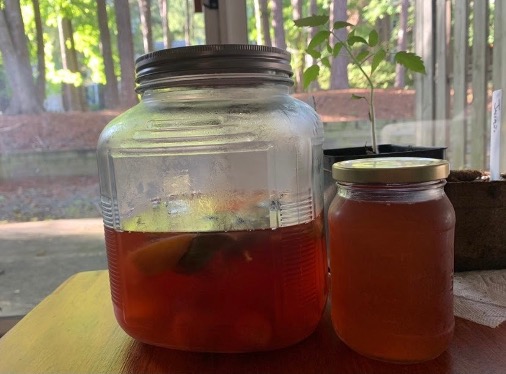By Riya Gohil
One COVID/quarantine hobby I’ve picked up over the course of the last year has been brewing kombucha. To my surprise, it’s a very simple process (for us humans). Once you start your first brew, you can brew as many brews as your heart desires.

What is Kombucha?
Kombucha is a fermented tea drink. It might not sound appealing, but it’s a tarty, tangy, naturally carbonated drink that can be flavored any way you want, especially if you’re the one brewing!
The Origins of Kombucha
Kombucha was first made in northeastern China about 2,200 years ago and used for its energizing and health benefits. About 600 years later, kombucha travelled to Japan to help the Emperor’s digestion problems. From there, kombucha started travelling to Russia, Europe, and North Africa as trade routes expanded. Now, kombucha is being consumed worldwide!

How is Kombucha made?
The key components of kombucha are tea (typically black or green tea), sugar, and a Symbiotic Culture Of acetic acid Bacteria and Yeast, otherwise known as SCOBY. The yeast and bacteria in the SCOBY are what really makes the kombucha…well, kombucha. When you let these three components of kombucha sit in a jar for about 7-10 days, a process called fermentation will occur. Fermentation is the metabolic process by which yeast and bacteria extract energy from sugars and carbohydrates. Unlike the cells in our body, which undergo an oxygen-dependent process called cellular respiration to harvest energy, fermentation occurs in the absence of oxygen. The yeast and bacteria from the SCOBY generate ethanol, ATP, and NADH (the energy currencies in cells) using sugar (glucose) as a starting product. Fermentation also releases carbon dioxide as a byproduct, and thus the drink naturally carbonates itself! The pH levels also go down during fermentation, so it is important to stop the brewing process before your kombucha gets too acidic, or you will risk the kombucha tasting like vinegar. The combination of these biological processes that bacteria and yeast engage in give kombucha its sweet, tarty, slightly acidic taste. Kombucha can also be infused with various fruits and spices after the first brew! Below are ingredients and instructions to start your own brew of kombucha. What flavors would you add to your own kombucha?
Ingredients/Equipment
- SCOBY
- Kombucha starter liquid
- Sugar
- Black or Green tea (or both!)
- Filtered water
- 1 gallon glass Jar
- Swing-top bottles
- Cotton cloth
- Rubber band
- Thermometer
Note: SCOBY and Kombucha starter liquid can be bought online at specialized kombucha shops like the one linked above, or these kits are sometimes found at your local grocery store.
Instructions
- Bring 4 cups of filtered water to a boil, then turn off the heat.
- Add 3 tablespoons (or 6 bags) of tea to the pot. Let steep for 5-7 minutes. Remove tea.
- Add 1 cup sugar to the pot and stir.
- Pour sweet tea mixture into the glass brewing jar.
- Add 8 cups of cold filtered water to the jar.
- Once the sweet tea mixture is between 68-86℉, add SCOBY and Kombucha starter liquid to the jar.
- Cover the jar with cotton cloth and seal with a rubber band.
- Place the jar in a warm place that is out of direct sunlight. The kitchen counter away from a window works as a perfect place. Leave the jar there for about 7-9 days and do not move the jar.
- After about 7-9 days, you will notice a white/yellow layer at the top of the brew — this is your new SCOBY! Use a spoon to test the kombucha. If it is still too sweet, let kombucha ferment for a few more days.
- When the kombucha is done, you can enjoy it as is or undergo a second round of fermentation to add flavor and carbonation.
- To start a new brew of kombucha, save 1-2 cups of finished kombucha — this is your start liquid. Follow the above instructions again to keep brewing! SCOBYs last about 5 brews and then should be disposed of.
- To add flavor and carbonation, transfer ready kombucha to swing-top bottles. Add in your favorite fruits/spices. Seal the bottles tightly and store in a dark, warm place for 2-5 days.
- After 2-5 days, move the bottles to the fridge to chill the kombucha. Your kombucha is now ready!
